The California Bicycle Summit takes place in Oakland from April 6-9. Find more information and register here.
Advocates in Los Angeles and Oakland recently talked about some of the successful advocacy work they've undertaken to make streets safer for all users - and what it took to get some of these projects done.
A Sunset Blvd For Everybody
Frustration at the slow pace of making Sunset Blvd safer drove Sunset4All! to skip the city engineering department temporarily. The advocates had an idea about how to make the street safer; the city's bike plan said the area should have protected bike lanes, and it was in the city's Mobility Plan, as well as on its Vision Zero network.
But the city wasn't doing anything with all the good ideas.
"It's a chicken-and-egg thing," said Derrick Paul, a founder of Sunset4All! "The project needed preliminary engineering, but councilmembers didn't want to do it unless there was community support. We found that it was hard to get support if we couldn't offer details."
"So we crowdfunded the cost of that preliminary engineering. We raised $60K to fund outreach and engineering from 360 small local donors, and one angel investor who provided a 100% match."
Hiring their own engineer to start the planning helped their advocacy in a number of ways. "Having a lot of small local donors is a good potential metric for businesses, to gauge interest in the project. And having the preliminary engineering done has shifted the power structure in our outreach, making it easier to explain what the finished project could look like and how it would benefit people."
Sunset Blvd is a busy, wide road, used by 40,000-plus vehicles daily. It is also a local main street, lined with businesses and reached by high number of people on foot and on bike. It is also a high-injury corridor, whose car-centric design made conflicts between modes inevitable. In other words, a somewhat typical L.A. street.
CicLAvia showed the demand for cycling was there, it was hard to sustain because there wasn't any safe infrastructure for people to keep biking.
"We want to make it safe and comfortable," said Paul "We also want it to be scaled to humans, not just vehicles. This would have regional implications, too, since Sunset is the connection to the wider regional for more than 100,000 local residents. It is also a mountain pass, with no alternative parallel routes" for people who want to get around by bike or walking.
Now, said Paul, "We have momentum. There's a city council election coming up, and all the candidates support the project. One even made a point of praising it as a model of successful community outreach."
Telegraph Avenue Protected Bike Lanes
Dave Campbell of Bike East Bay and Chris Hwang of Walk Oakland Bike Oakland followed up with a discussion of the ups and downs of getting protected bike lanes on Telegraph Avenue in Oakland - which is where the California Bike Summit will take place in April.
"We're checking in around Chapter 7 of an 8- or 9-chapter story," said Campbell about the project, which not only took a long time to implement but is being updated - and was threatened by dissatisfaction with the pilot phases, which entailed flimsy flex posts, paint-only protection, and lots of vehicles parking in the bike lanes, behind a row of parked cars.
This was the first parking-protected bike lane most street users had seen, so it took some getting used to. But the city did a study about six months after putting in its initial phase of the project and found big changes. "We found more people biking and walking; injuries went down; traffic is slower but still flows," said Campbell. "Also, sales went up - we're not sure about whether that was because of the pilot, but they did go up more than other business areas in the city."
It was not perfect - which is okay for a pilot project that is testing out new ideas. The city tried several options, including planter boxes to keep cars out of the protected lanes, but drivers learned they could push them out of the way so they frequently ended up in the bike lane. The first bus boarding islands had lots of problems. Pedestrians were still not always comfortable crossing the street because the parking, now further into the street, put them closer to moving traffic and there wasn't always a car parked there to protect them.

Then, "about three years in, sales started going down," said Campbell. "Businesses wanted to go backwards" and take out some of the changes. "We convinced city to put in bigger bollards; we wanted them to add purple paint, but didn't get that. The Business Improvement District was mad, and claimed that First Fridays [a weekly open street event] would not be able to happen with all that stuff in the street."
Then one councilmember said she'd had it, and started pushing the city to remove the protected bike lanes. There was a sense that the street had been designed according to the dictates of the bike advocates, rather than the community.
"That started an entire new process," said Campbell. "Oakland was very intentional about equity, and we welcomed that opportunity."
"The harder part of communication was dispelling the sense that walking and biking advocates were not from the community," said Hwang. "Granted, there are some who aren't, but we have a commitment to be a megaphone for our community. It was important to demonstrate that we were speaking from truth we were hearing on the ground."
In an effort to find out what "the community" wanted, the advocacy groups developed surveys, the council developed surveys, even the business owners developed their own, but it was clear they weren't doing much to help further the conversation.
It became very important for the council members themselves to ask: who are the vulnerable populations we need to focus on? "That couldn’t come from bike advocacy organization," said Hwang. "We need to empower our community members to reach out on their own, and build a wider base of conversation."
"We hoped to have a better idea of what makes an equitable street safety project," said Campbell. "Our volunteers were able to raise information about who was using the streets. We found that business liked the street changes, but were concerned about other things, such as parking and deliveries."
Transit riders also became a central part of the conversation. In addition, community members made videos of themselves using the bikeways and roadways to show the council what their experience was like.
In the end, the council did vote to install the protected lanes permanently, with concrete curbs and concrete bus boarding islands - making the project permanent and less confusing, and making it more difficult for vehicles to park in the bike lanes.
When asked what were their most effective strategies, Dave Campbell talked about the way the Bike East Bay works intentionally with business districts, reaching out to get their support ahead of time. They've also worked to get walk and bike friendly councilmembers elected to the city council.
Chris Hwang said that "events are a great way to bring people, including decision makers, to the site to experience what it can be like." Before the Telegraph Avenue road diet happened, for several years running Bike East Bay sponsored a pop-up bike lane, complete with temporary green lanes and potted plants, to give people an idea what this newfangled idea was.
The events don't have to be big, or formal. "CicLAvia is amazing," said Hwang. But also "I saw more informal group rides during COVID than any other time. It doesn't take formal events to energize the grassroots. the missing piece is the conversation that connects those rides/events/fun to what CAN be an every day event."
Paul agreed. He said that organizing something as simple as meeting for coffee, followed by a walk along Sunset Blvd, offered an opportunity to talk about safety issues people experience, and come up with solutions for them.






